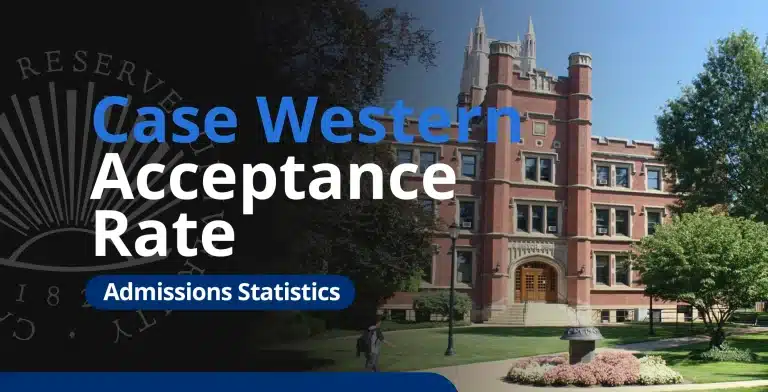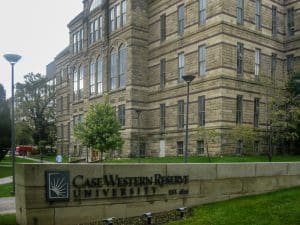While Case Western Reserve University has already welcomed its Class of 2029, it has not yet released official data on its acceptance rate. However, if past admissions trends hold, it’s safe to assume that the latest rate is around—or possibly lower than—the 37.8% reported for the Class of 2028. That may not be the most competitive rate out there, but it still takes strong academics and a solid application to get in.
So, what does this mean for you? A lot! In this blog, we’ll break down Case Western’s acceptance rates and other key admissions stats, like the yield rate, transfer acceptance, and waitlist chances. Plus, we’ll help you figure out what these numbers mean for your own application.
- What Is Case Western’s Acceptance Rate?
- Case Western Acceptance Rate Trends
- Case Western Regular Decision Acceptance Rate
- Case Western Early Decision Acceptance Rate
- Case Western Early Action Policy and Important Dates
- How to Get Accepted into Case Western
- Case Western Transfer Acceptance Rate
- Case Western Waitlist Acceptance Rate
- Frequently Asked Questions
- Takeaways
What Is Case Western’s Acceptance Rate?
For the Class of 2028, Case Western had an acceptance rate of 37.8%. Out of 37,082 applicants, only 14,010 were admitted. While this isn’t as selective as some Ivy League schools, it still means not everyone gets in.
But here’s the thing—how you apply can actually impact your chances. Let’s take a closer look at what that means:
| Application Type | Total Applications | Total Accepted | Acceptance Rate |
| Early Decision | 804 | 298 | 37.1% |
| Regular Decision | 36,278 | 13,712 | 37.8% |
| Total | 37,082 | 14,010 | 37.8% |
Case Western got 37,082 applications for the Class of 2028. Out of those, 804 students went for Early Decision, while 36,278 applied through Regular Decision. In the end, 298 Early Decision applicants and 13,712 Regular Decision applicants were accepted. The overall acceptance rate was 37.8%, with Early Decision slightly lower at 37.1%, and Regular Decision at 37.8%.
Unlike some schools where applying Early Decision gives you a big advantage, Case Western’s numbers don’t show much of a difference. That means applying early won’t necessarily improve your chances. But if Case Western is your top choice, Early Decision could still be a smart move since it’s binding and tells the school you’re all in.
Case Western yield rate
The yield rate—which is the percentage of admitted students who actually enroll—is another key stat to look at. For Case Western’s Class of 2028, 1,619 out of 14,010 admitted students chose to attend, leading to a yield rate of 11.6%.
To put that into perspective, the national average yield rate for four-year nonprofit colleges in fall 2022 was 30%. Private colleges were slightly higher at 33%, while public colleges sat at 25%. Case Western’s 11.6% yield rate is on the lower end, meaning a large number of accepted students chose to enroll elsewhere.
What does this mean for you? First, if you’re waitlisted, you might have a decent shot, since Case Western needs to fill spots from students who decline their offers. Second, the lower yield suggests that while Case Western is well-respected, it might not be the first choice for many admitted students. That said, if it’s your top choice, making that clear in your application can only help.
Case Western Acceptance Rate Trends
Case Western’s Common Data Set shows that acceptance rates have been all over the place in the past five years. The numbers have fluctuated so much that spotting a clear trend isn’t easy:
| Case Western Class | Total Applications | Total Accepted | Acceptance Rate |
| 2028 | 37,082 | 14,010 | 37.8% |
| 2027 | 39,039 | 11,193 | 28.7% |
| 2026 | 38,701 | 10,607 | 27.4% |
| 2025 | 33,232 | 10,049 | 30.2% |
| 2024 | 29,084 | 8,804 | 30.3% |
Over the past five years, Case Western’s acceptance rates have been anything but predictable. For the Class of 2028, the acceptance rate jumped to 37.8%, a sharp increase from the previous year’s 28.7% for the Class of 2027. Before that, the numbers were even lower, with the Class of 2026 at 27.4% and the Class of 2025 at 30.2%. The Class of 2024 had a similar rate at 30.3%.
What’s interesting is that while the number of applications has generally increased, the acceptance rate hasn’t followed a clear pattern. Some years, more students applied, yet fewer got in. Other years, applications dipped slightly, but more students were accepted.
This inconsistency makes it tough to predict future trends, but one thing is clear—getting into Case Western is competitive, and the numbers can change drastically from year to year.
Case Western acceptance rate vs Ivy League schools
Compared to Ivy League schools, Case Western’s acceptance rate is much higher, making it far less selective:
| Ivy League School | Acceptance Rate (Class of 2028) |
| Harvard University | 3.6% |
| Yale University | 3.7% |
| Columbia University | 3.85% |
| Princeton University | 4.6% |
| Brown University | 5.2% |
| Dartmouth College | 5.3% |
| University of Pennsylvania | 5.4% |
| Cornell University | 8.4% |
Ivy League schools are still some of the hardest to get into, but Case Western has seen its own shifts in competitiveness. For the Class of 2028, Case Western’s acceptance rate jumped to 37.8%, which is much higher than the ultra-low rates at Harvard (3.6%), Yale (3.7%), or Columbia (3.85%).
Even when compared to the “easier” Ivies like Brown (5.2%), Dartmouth (5.3%), and Cornell (8.4%), Case Western’s acceptance rate is still on the higher side. That said, this doesn’t mean getting in is effortless. With tens of thousands of applicants each year, every admitted student has worked hard to earn their spot.
Case Western Regular Decision Acceptance Rate
For the Class of 2028, Case Western’s Regular Decision (RD) acceptance rate landed at 37.8%. Out of 36,278 applications, 13,712 students were admitted. Unlike some highly selective schools where Regular Decision is significantly tougher than Early Decision, Case Western’s acceptance rates remain fairly steady across both application types.
Here’s how Case Western RD acceptance rates have changed in recent years:
| Case Western Class | Total Applications | Total Accepted | Acceptance Rate |
| 2028 | 36,278 | 13,712 | 37.8% |
| 2027 | 38,115 | 10,957 | 28.7% |
| 2026 | 37,610 | 10255 | 27.3% |
| 2025 | 32,344 | 9731 | 30.1% |
| 2024 | 28,122 | 8438 | 30% |
Over the last five years, Case Western’s Regular Decision acceptance rates have been all over the place. For the Class of 2028, the acceptance rate jumped to 37.8%, a big jump from 28.7% for the Class of 2027. Before that, rates were even lower—27.3% for the Class of 2026, 30.1% for 2025, and 30.0% for 2024.
The number of applications has also been pretty unpredictable, swinging from 28,122 (Class of 2024) to a high of 38,115 (Class of 2027). Some years, more students applied but fewer got in, while other years, fewer students applied but more were accepted. The Class of 2028 stands out with a noticeably higher acceptance rate, but it’s hard to say if this will continue.
Case Western Regular Decision deadline and notification date
For students aiming to join Case Western Reserve University through Regular Decision, mark January 15 on your calendar—that’s the application deadline. After submitting your application, expect to hear back by March 22, which is when admission decisions are typically released. If you’re accepted, you’ll have until May 1 to confirm your enrollment.
Keep in mind, these dates can vary slightly each year, so it’s a good idea to check the university’s official admissions page for the most current information.
Case Western Early Decision Acceptance Rate
For the Class of 2028, Case Western’s Early Decision (ED) acceptance rate was 37.1%. While this is slightly lower than the Regular Decision (RD) acceptance rate of 37.8%, the difference isn’t as drastic as it is at some other schools. Out of 804 ED applicants, only 298 received offers.
The school’s Early Decision acceptance rate has not been consistent in the last five years:
| Case Western Class | Total Applications | Total Accepted | Acceptance Rate |
| 2028 | 804 | 298 | 37.1% |
| 2027 | 924 | 236 | 25.5% |
| 2026 | 1,091 | 352 | 32.3% |
| 2025 | 888 | 318 | 35.8% |
| 2024 | 962 | 366 | 38% |
Over the last five years, Case Western’s Early Decision (ED) acceptance rates have been pretty up and down. For the Class of 2028, the ED acceptance rate was 37.1%, a big jump from 25.5% the year before. Before that, rates were 32.3% for 2026, 35.8% for 2025, and 38.0% for 2024.
The number of ED applicants has also been all over the place. The Class of 2026 had the most, with 1,091 applications, while the Class of 2028 had the least, with 804. Even though fewer students applied in 2028, more got accepted compared to the previous year. With numbers shifting so much, it’s hard to predict trends, but if Case Western is your top choice, applying ED could still be a smart move.
Unlike some schools where ED gives you a huge advantage, Case Western’s ED and Regular Decision (RD) acceptance rates are pretty close. This means applying early won’t automatically boost your chances, but since ED is binding, it shows the school you’re serious about attending, which might work in your favor. It’ll be interesting to see how these numbers change in the future.
Case Western Early Decision policy
Case Western’s Early Decision (ED) program is binding, meaning if you’re accepted, you must withdraw all other college applications and commit to Case Western. The only exception is if you applied for financial aid—you can wait to review your aid package before making it official.
Since ED is a firm commitment, students who apply early often have a slightly higher acceptance rate. By choosing ED, you’re showing Case Western that it’s your top choice, which helps the admissions team shape the incoming class with more certainty. While ED doesn’t give a massive admissions boost, it can still be beneficial for strong applicants who are set on attending.
Here’s what happens if you apply ED:
- Admit. You’re in! Time to celebrate—you’re officially heading to Case Western.
- Defer. Your application moves to the Regular Decision round for another review.
- Deny. Unfortunately, Case Western won’t be an option for you this cycle.
ED is a great option if you’re 100% sure about Case Western and have a solid application ready early. But keep in mind, ED locks you in, so if you’re hoping to compare financial aid offers from multiple schools, you’ll want to think carefully before committing.
Case Western Early Decision deadline and notification date
If you’re considering applying to Case Western Reserve University through Early Decision, here are the important dates to keep in mind: Early Decision I applications are due by November 1, with admissions decisions typically released around December 7. For Early Decision II, the application deadline is January 15, and you’ll receive your decision by approximately February 10.
Keep in mind, these dates can vary slightly each year, so it’s a good idea to check the university’s official admissions page for the most current information.
Case Western Early Action Policy and Important Dates
Case Western Reserve University doesn’t share its Early Action (EA) acceptance rates in its Common Data Set, but they do offer an EA option for students who want to apply early without making a binding commitment. Early Action is non-binding, meaning you can apply early, get your decision sooner, and still have time to decide.
The EA deadline is November 1, and Case Western typically releases decisions by December 21. This gives you plenty of time to weigh your options before the May 1 national decision deadline.
Keep in mind that while EA gets you an early answer, it doesn’t provide the same potential admissions boost as Early Decision (ED), which is binding. So if Case Western is your absolute top choice and you’re ready to commit, ED might be the better way to go.
How to Get Accepted into Case Western
If you’re applying to Case Western Reserve University, it helps to know what the admissions team values. Academics come first—strong grades and challenging coursework are key. They want to see that you’ve pushed yourself in high school and are ready for the rigor of college-level classes.
But numbers aren’t everything. Case Western also looks for students who are more than just their GPA. They value applicants who are engaged in meaningful extracurriculars, leadership roles, or unique experiences that set them apart. Whether it’s research, community service, athletics, or a creative passion, showing what makes you different can strengthen your application.
So, how can you stand out? Here’s what you can do:
Target GPA
Case Western doesn’t have a minimum GPA requirement, but let’s be real—strong academics matter. Most admitted students have a GPA between 3.7 or higher, meaning they’re among the top performers in their high schools.
If your GPA isn’t quite there, don’t panic. You can make up for it with strong test scores, compelling essays, or impressive extracurriculars. Taking AP, IB, or honors courses can also show admissions that you’re up for the challenge of Case Western’s intensive academics. The key is proving that you’re ready to handle the workload and succeed once you’re on campus.
Target test scores
Case Western is test-optional, but strong SAT or ACT scores can still give your application a boost. Here’s a look at the typical scores of admitted students:
| Standardized Test | 25th Percentile Score | 75th Percentile Score |
| SAT | 1450 | 1530 |
| ACT | 32 | 35 |
If you plan to submit scores, aim for the higher end of the range (1530 for SAT and 35 for ACT) to show you’re ready for Case Western’s academic rigor.
Not submitting test scores? No worries—just make the rest of your application shine. Focus on your extracurriculars, write strong essays, and showcase leadership or unique experiences to stand out. Since Case Western looks at applications holistically, showing who you are beyond test scores can still make a strong impression.
Extracurriculars
Case Western Reserve University cares a lot about extracurriculars, looking for students who show leadership, passion, and a real commitment to their interests and communities. They want to see that you’ve gone beyond just academics and have made an impact outside the classroom.
If you’ve been active in high school clubs, you might find a great fit at Case Western. Joining organizations like the Case Neuroscience Society or the CWRU Science Olympiad can show your dedication to science and research. These types of activities prove that you’re eager to collaborate, explore, and push the boundaries of what you’re learning.
Case Western also values students who bring creativity and cultural awareness to campus. Being part of multicultural clubs, theater productions, or music groups helps show that you appreciate diversity and the arts. No matter what you’re involved in, what matters most is your passion and long-term commitment to what you love doing.
Essays
You’ll need to submit a personal statement through the Common Application or Coalition Application. If you’re applying to the Pre-Professional Programs, you’ll also need to write two supplemental essays.
These essays are your chance to showcase your personality, share your unique perspective, and explain why Case Western is the perfect fit for you. Be specific—mention programs, professors, or campus opportunities that excite you and how you see yourself contributing to the Case Western community.
Recommendation letters
When applying to Case Western Reserve University, you’ll need to submit three letters of recommendation: one from your school counselor and two from teachers who have taught you in core academic subjects. It’s best to choose teachers who know you well and can speak to both your academic abilities and personal character.
Strong, specific letters can significantly enhance your application by providing insight into your strengths and potential contributions to the Case Western community.
Want to know how to get into Case Western? Here is a simple guide that breaks down the admissions process and gives you tips to make your application shine.
Case Western Transfer Acceptance Rate
For the Class of 2028, Case Western’s transfer acceptance rate was 24%. Out of 713 applicants, only 171 got in.
That’s a much higher rate than at some ultra-selective schools, but it still means transferring to Case Western isn’t a guarantee—you’ll need a strong application to stand out.
Case Western welcomes transfer students from all kinds of backgrounds, but they’re looking for solid college grades, meaningful extracurriculars, and a clear reason for transferring. Most students who get in join as sophomores, though a few juniors make the cut. The key is proving that Case Western is the right place for you and that you’re ready to thrive on campus.
One of the biggest parts of your application is the essay. Case Western wants to know why you’re choosing them. This is your chance to talk about specific programs, research opportunities, or campus resources that fit your goals. Show them you’ve done your homework and explain how Case Western will help you reach the next level.
Important dates and transfer requirements
Transferring to Case Western Reserve University? Here’s what you need to know about important dates and requirements:
- Fall semester early plan. Application deadline is March 15, with decisions starting April
- Fall semester regular plan. Application deadline is July 1, with decisions typically within two weeks of application completion.
- Spring semester. Application deadline is November 15, with decisions typically within two weeks of application completion.
Here are what you need to apply as a transfer student:
- Completed application. Submit through the Common Application or Coalition Application.
- Official transcripts. Provide transcripts from all post-secondary institutions attended.
- High school transcript. An official high school transcript is required.
- College instructor recommendation. At least one letter of recommendation from a college instructor is required.
- Minimum GPA. A minimum college GPA of 3.2 is typically expected.
- Statement of good standing. A statement confirming good standing from your current or previous institution is required.
Case Western Waitlist Acceptance Rate
Case Western hasn’t released waitlist data for the Class of 2028, but if past trends are any clue, getting off the waitlist isn’t easy. For the Class of 2027, over 11,800 students were placed on the waitlist, 7,940 chose to stay on it, and only 1,141 got in—which means the waitlist acceptance rate was just 9.6%.
Like at many competitive schools, Case Western’s waitlist numbers change a lot every year. How many students get off the list depends on how many admitted students actually enroll. If more students accept their offers than expected, fewer spots open up for waitlisted applicants.
But if fewer students enroll, your chances improve. While the waitlist isn’t a guaranteed way in, it’s still worth staying on it—especially if Case Western needs to fill more spots later on.
What to do if you’re waitlisted at Case Western
Getting waitlisted at Case Western isn’t the same as being rejected—it’s more like a “maybe”. The admissions team sees potential in your application, but they don’t have a spot for you right now. The waitlist gives them a backup pool of students in case some admitted students decide to enroll elsewhere.
While there’s still a chance, being waitlisted doesn’t guarantee admission, so it’s important to stay realistic and have a solid backup plan. You should commit to another school while keeping an eye on Case Western.
Here’s what you can do to improve your chances:
- Confirm your spot. Follow Case Western’s instructions to accept your place on the waitlist. If you don’t, you won’t be considered.
- Send a Letter of Continued Interest (LOCI). A short, genuine email reaffirming your excitement about Case Western can make a difference. Mention any new achievements since you applied.
- Keep your grades up. Case Western values academic consistency, so continue working hard in your classes and extracurriculars.
- Stay realistic. The waitlist process is unpredictable. While you can hope for good news, focus on the school where you’ve been accepted so you’re ready either way.
The best way to avoid the waitlist uncertainty is to submit a strong application from the start. But if you do end up on the waitlist, following these steps can help you stand out.
Frequently Asked Questions
1. What is Case Western’s latest overall acceptance rate?
Case Western’s overall acceptance rate for the Class of 2028 was 37.8%. Out of 37,082 applicants, 14,010 were admitted.
2. What is Case Western’s Early Decision acceptance rate?
For the Class of 2028, Case Western’s Early Decision (ED) acceptance rate was 37.1%. Out of 804 students who applied ED, 298 were admitted.
3. What is Case Western’s Regular Decision acceptance rate?
Case Western’s Regular Decision (RD) acceptance rate for the Class of 2028 was 37.8%. Out of 36,278 RD applicants, 13,712 were offered admission.
4. What is Case Western’s transfer acceptance rate?
The transfer acceptance rate for the Class of 2028 was 24%. Out of 713 transfer applicants, only 171 students were admitted.
5. What is Case Western’s waitlist acceptance rate?
Case Western hasn’t published waitlist data for the Class of 2028, but for the Class of 2027, 11,841 students were waitlisted, 7,940 chose to stay on the list, and only 1,141 were eventually admitted—resulting in a 9.6% waitlist acceptance rate.
Takeaways
The Case Western acceptance rate shows that while it’s not as selective as Ivy League schools, admission is still competitive. If you’re aiming for a spot, here are five key things to remember:
- Case Western’s overall acceptance rate for the Class of 2028 is 37.8%. Out of 37,082 applicants, only 14,010 were admitted.
- Case Western’s acceptance rate is higher than top-tier schools like Duke and the Ivy League, but it still requires strong academics and extracurriculars to stand out.
- Early Decision applicants had a slightly lower acceptance rate (37.1%) compared to Regular Decision (37.8%). Unlike some schools where ED provides a major boost, Case Western’s rates are nearly the same, so applying early won’t drastically improve your chances.
- A GPA around 3.7–4.0 and SAT/ACT scores in the upper ranges (SAT 1510, ACT 34) can strengthen your application, along with strong essays and extracurricular involvement. Case Western is test-optional, but high scores can give you an edge.
- Since admissions can be competitive, you might want to get advice from a college admissions expert to help strengthen your application and make it stand out.

Eric Eng
About the author
Eric Eng, the Founder and CEO of AdmissionSight, graduated with a BA from Princeton University and has one of the highest track records in the industry of placing students into Ivy League schools and top 10 universities. He has been featured on the US News & World Report for his insights on college admissions.






















